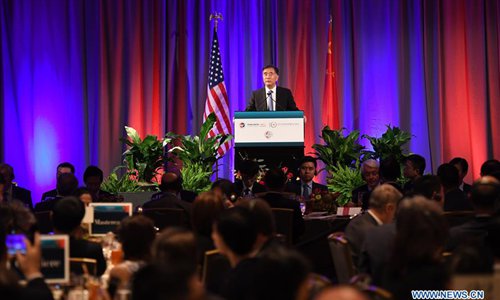
Chinese Vice Premier Wang Yang addresses a business luncheon ahead of the first China-US Comprehensive Economic Dialogue in Washington, the United States, on July 18, 2017. (Xinhua/Yin Bogu)
One-year China-U.S. cooperation plan expected
The well-developed trade exchanges between China and the U.S. benefit both sides, experts said, as the first round of bilateral economic talks kicked off on Wednesday with the expectation that an extension from a 100-day to a one-year cooperation plan will help smooth frictions.
"Cooperation is the only right choice for our two countries. The giant ship of China-U.S. economic and trade relations is sailing on the right course," Chinese Vice Premier Wang Yang said Tuesday in a keynote speech at a business luncheon in Washington, DC.
Experts predicted that sensitive issues between the two sides would be dealt with during a longer cooperation process, and the well-developed Sino-U.S. trade ties could help dispel the negative influence of protectionism.
The Chinese Ministry of Commerce said they expect the China and the U.S. to discuss a one-year cooperation plan during the Comprehensive Economic Dialogue (CED).
Wang co-chaired the first round of the CED on Wednesday in Washington, DC with U.S. Treasury Secretary Steven Mnuchin and Commerce Secretary Wilbur Ross.
The business communities in both countries had been reassured by the joint decision to establish the four high-level dialogue mechanisms, including the CED, and the 100-day Plan for China-U.S. economic cooperation, Wang said.
"Launching the China-U.S. 100-day action plan enhanced mutual trust, and it helped create a harmonious atmosphere for the Wednesday talks. It means they can touch on more sensitive issues with a full understanding of each other's concerns," said Liu Zhiqin, a senior fellow at the Chongyang Institute for Financial Studies at the Renmin University of China.
The 100-day action plan was initiated after Chinese President Xi Jinping and U.S. President Donald Trump met at Mar-a-Largo in Florida in April, signing agreements on agriculture products, energy and banking and financial services.
As more details of the one-year plan are revealed, there will be a new timetable and a new plan for the two sides to deal with problems on the trade deficit, Liu said.
The U.S. is calling for broader market access to China, and China has urged the U.S. to lift high-tech export barriers.
"U.S. investors want China to open its capital markets, and hope to enter China's banking, financial and insurance industries, and China has made efforts in response to their requests. But it can't be done immediately as a sudden influx of foreign capital would affect the stability of China's current market system," Liu said.
Although the trade deficit is the key concern of the U.S. side, "it should be noted that much of China's trade surplus with the U.S. are exports with less added value or made by U.S. enterprises in China. And the U.S. has adopted a different statistical approach from China on the trade deficit with China," said Bai Ming, a research fellow at the Chinese Academy of International Trade and Economic Cooperation.
Chinese experts have called on the U.S. to approve exports of high-tech products to China and for China to further open up its services sector, especially the financial and tourism industries, to cut the deficit.
"However, the U.S., which still adopts a Cold War mentality, uses national security as an excuse and is reluctant to lift barriers on high-tech exports to China. The U.S. also fears losing its leading position in the high-tech field if China acquires technologies from its products," Bai told the Global Times.
American businesses have not had their fair share of the "cake" due to outdated U.S. regulations on export controls. In 2001, U.S. high-tech exports to China accounted for 16.7 percent of China's total imports of such products, while last year the percentage dropped to 8.2 percent, Wang said.
A bigger cake
Despite the frictions, experts reached by the Global Times were optimistic over future trade with the U.S.
"It's understandable that some governments will take more measures to protect their own enterprises, but it should not break the trade balance with other nations. Trump, who focuses more on commercial interests, may learn this from his experience over the past months in dealing with Chinese issues," Liu said.
Wang also touched on protectionism in his keynote speech, saying that "We understand that quite a few Americans support 'Buy American, Hire American,' just as in China there is also a voice for 'Buy Chinese, Hire Chinese.' But it is important that both sides come to realize with cool heads that given the depth of our business cooperation, neither Chinese nor Americans can do without goods from the other country."
"The well-developed trade exchanges between China and the U.S. will also help dispel the negative influence of protectionism to some extent. Although trade friction is inevitable in the future as competition between China and the U.S. may increase, the two sides will make efforts to make a bigger cake and exchange ideas on disputes," Bai said.


















































